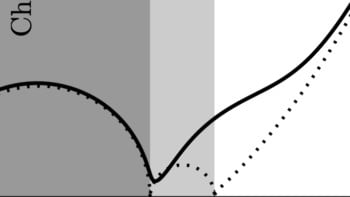
When the leaves of the aquatic lotus plant, Nelumbo nucifera, float on water they are large and flat, with short ruffles along their edges. Intriguingly, though, lotus plants that grow on stems elevated above the water produce cone shapes with larger, longer undulations. Now a team of engineers in China has found that the difference isn’t genetic but is instead due to mechanical effects created by the water on which the leaves float.
Fan Xu, a mechanical engineer at Fudan University in Shanghai, started studying the shapes of lotus leaves when he noticed the different leaf shapes growing in and around ponds in China.
In the latest study, published in Physical Review Letters, Xu and colleagues turned to mathematical models and a leaf-like material to test the hypothesis that water conditions influence leaf shape.
To accurately model how leaves grow, the team cut leaf shapes out of a rubber material that grows when in contact with water. Because sunlight stimulates lotus-leaf growth, plants tend to curve towards the sun and grow at different rates in different parts of the leaf, depending on where the light hits. To mimic this, the researchers wetted the fake leaves at points where growth would be expected. They also floated some of the model leaves on water, to observe how this affected their growth.
Energy differences emerge
Both their model leaves and the mathematical simulations produced leaves that matched those seen on ponds and waterways – flat, floating leaves with tight ruffles around their edges and non-floating cone-shaped leaves with larger undulations flowing towards the centre of the leaf. The explanation for these patterns turns out to be a combination of the biophysical effect of the layer of water on the leaf’s underside, plus the leaf’s natural tendency to grow in as energy-efficient a manner as possible.
When the lotus leaves are free from the water, Xu and colleagues explain, the models show that the most energy efficient way for lotus plants to grow is to produce a cone shape with long, large wave-like oscillations. For a leaves growing on water, though, producing such a shape would require the leaves to lift the water that adheres to their undersides. Instead, leaves grow flat and ruffle at the edges, which is much more energy efficient. Leaves on water also produce wave-like undulations, rather than growing flat, because they produce more material and surface area when they are growing than can be contained in a flat sheet – meaning that they buckle and wrinkle.
“We find, both theoretically and experimentally, that the short-wavelength buckled configuration is energetically favourable for growing membranes lying on liquid, while the global buckling shape is more preferable for suspended ones,” the study authors conclude.
The researcher say their work highlights how biophysical effects can affect plant morphogenesis. Such knowledge could, they add, be harnessed to control the morphology of human-made materials.



